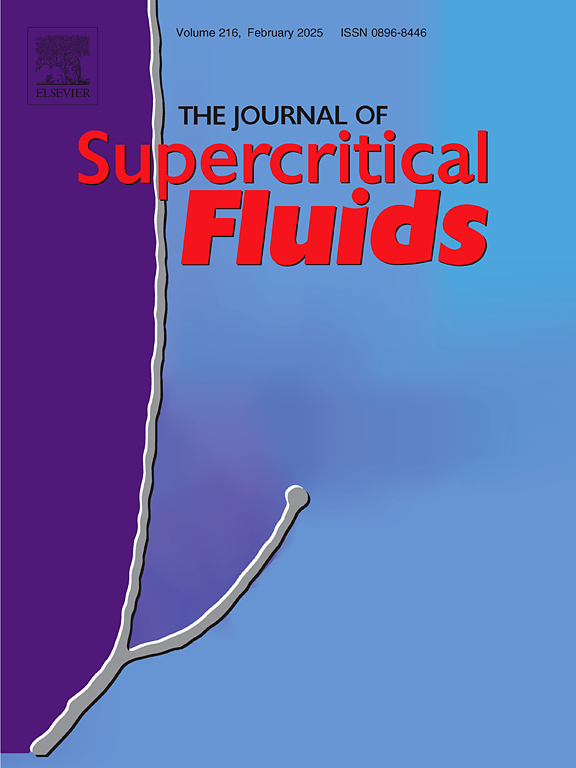Numerical simulation of clean separation through gas-liquid phase transition of gas products from biomass gasification in supercritical CO2 using a supersonic nozzle
IF 3.4
3区 工程技术
Q2 CHEMISTRY, PHYSICAL
引用次数: 0
Abstract
The supercritical CO2 biomass gasification technology can both reduce CO2 to produce CO gas and efficiently utilize biomass energy. This study employs a supersonic nozzle to achieve clean separation of gas products from supercritical CO2 biomass gasification, enabling CO2 recycling and reducing the cost of further CO purification. Numerical simulation results indicate that the inlet conditions of the nozzle significantly affect the gas-liquid phase transition of the mixed gas, allowing for the recovery of approximately 0.065 mass fraction of CO2. The shape of the nozzle's convergent section has negligible influence on the phase transition of the gas, whereas increasing the length of the divergent section effectively enhances the recovery of CO2 at the outlet by promoting droplet growth. Variations in the composition of the mixed gas have a certain impact on the number of droplets formed during the phase transition, but the overall effect on the condensation process is minor.
超临界CO2条件下生物质气化产物气-液相变洁净分离的数值模拟
超临界CO2生物质气化技术既能减少CO2产生CO气体,又能有效利用生物质能源。本研究采用超音速喷嘴实现超临界CO2生物质气化气体产物的清洁分离,实现CO2的循环利用,降低进一步CO净化的成本。数值模拟结果表明,喷嘴的入口条件对混合气体的气液相转变有显著影响,允许回收约0.065质量分数的CO2。喷嘴收敛段的形状对气体相变的影响可以忽略不计,而增加发散段的长度可以通过促进液滴生长有效地提高出口CO2的回收。混合气体组成的变化对相变过程中形成的液滴数量有一定的影响,但对冷凝过程的总体影响较小。
本文章由计算机程序翻译,如有差异,请以英文原文为准。
求助全文
约1分钟内获得全文
求助全文
来源期刊

Journal of Supercritical Fluids
工程技术-工程:化工
CiteScore
7.60
自引率
10.30%
发文量
236
审稿时长
56 days
期刊介绍:
The Journal of Supercritical Fluids is an international journal devoted to the fundamental and applied aspects of supercritical fluids and processes. Its aim is to provide a focused platform for academic and industrial researchers to report their findings and to have ready access to the advances in this rapidly growing field. Its coverage is multidisciplinary and includes both basic and applied topics.
Thermodynamics and phase equilibria, reaction kinetics and rate processes, thermal and transport properties, and all topics related to processing such as separations (extraction, fractionation, purification, chromatography) nucleation and impregnation are within the scope. Accounts of specific engineering applications such as those encountered in food, fuel, natural products, minerals, pharmaceuticals and polymer industries are included. Topics related to high pressure equipment design, analytical techniques, sensors, and process control methodologies are also within the scope of the journal.
 求助内容:
求助内容: 应助结果提醒方式:
应助结果提醒方式:


